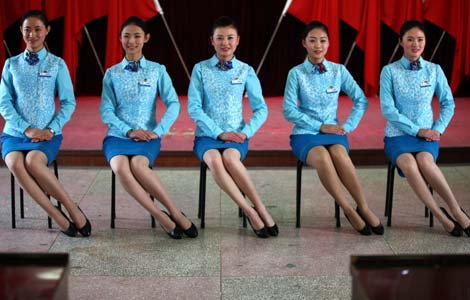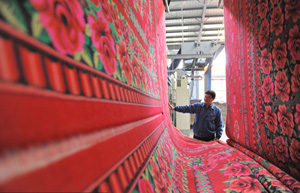Heilongjiang touts relationship with neighbor
By Fu Jing ( China Daily ) Updated: 2013-03-23 07:14:01![A Chinese businessman shows products to a visitor at the Greenwood International Trade Center in Moscow in October 2011. The center is the largest Chinese investment project in the fi eld of commerce in Russia. [JIANG KEHONG / XINHUA] Heilongjiang touts relationship with neighbor](../../img/attachement/jpg/site1/20130323/00221917dead12b7246b01.jpg) |
|
A Chinese businessman shows products to a visitor at the Greenwood International Trade Center in Moscow in October 2011. The center is the largest Chinese investment project in the field of commerce in Russia. [Photo/Agencies] |
Northeast China's Heilongjiang province, which accounts for nearly one-fourth of Sino-Russian trade volume, has been redoubling its efforts to further boost trade and economic activities with Russia's Far East region, the top provincial leader said.
Wang Xiankui, recently promoted from the position of provincial governor to Party chief, revealed the commitments ahead of President Xi Jinping's visit to Russia and Africa.
"Based on previous achievements, we are seeking more preferential and supportive measures from the central government to further develop trade and economic activities with Russia," Wang said in a recent interview.
Statistics show that the trade volume between Wang's province and Russia increased by 12.2 percent year-on-year in 2012, reaching $21.3 billion. The volume amounted for one-fourth of China-Russia trade, totaling $87.5 billion.
However, Heilongjiang's trade with other countries declined last year. With $2.11 billion in trade with the United States in 2012, the province's import and export volume decreased by 38.3 percent year-on-year. Trade with India totaled $570 million, down 46.4 percent.
Russia's statistics authorities said China kept its status as Russia's biggest trading partner, with volume seeing a 5.1 percent year-on-year increase in 2012.
"So our border trade has substantially boosted the economic exchanges between the two powers," Wang said.
Within Heilongjiang, 15 cities border Russia's Far East region, which has actively boosted exchanges. The focus is financial cooperation, infrastructure, wood processing, agriculture, and high-tech.
While the two countries have decided to boost bilateral trade to $100 billion by 2015 and $200 billion by 2020, Wang said Heilongjiang will play a bigger role in realizing the goal outlined by the two countries' leaders.
Tremendous opportunities exist for Heilongjiang to fulfill its role. At the national level, the Chinese government has tapped border economic cooperation with Russia as a policy priority, and Heilongjiang and the Inner Mongolia autonomous region have been benefiting from the policy.
Meanwhile, the Chinese government has invested in rail bridges and other infrastructure along the border in Heilongjiang to facilitate economic activities. And after Russia joined the World Trade Organization, it integrated itself faster into the global economic system.
China and Russia have decided to organize activities to boost tourism this year after naming 2012 as a "Year of Tourism" at the bilateral level. "This will further increase other exchanges through tourism," Wang said.
In 2011, China was Russia's second-biggest tourism destination, and Russia has become China's third-biggest destination. More than half of Russian tourists have entered China through borders along Heilongjiang, and about 53 percent of Chinese tourists left for Russia via the province.
"We are going to take more open attitudes and develop more projects to attract tourists from Russia and send Chinese tourists to Russia," Wang said.
Wang also said China has rented about 4,000 hectares of land in Russia's Far East region to plant soybeans and corn, which are mainly transported back to China. He said the quality of the soybeans and corn is in accordance with European standards, but the harvests have been levied with import taxes when they are sent back to the country.
"I suggest that the central government consider decreasing or remitting the taxes to encourage the land rent, bring benefits to Russia and ensure the country's food security," Wang said.
fujing@chinadaily.com.cn
|
|
|
|
|
|
|
|
European Weekly
 Gear change
Gear change
'Sustainable development', 'decisive role for markets' are the new buzzwords for Chinese economy.






















